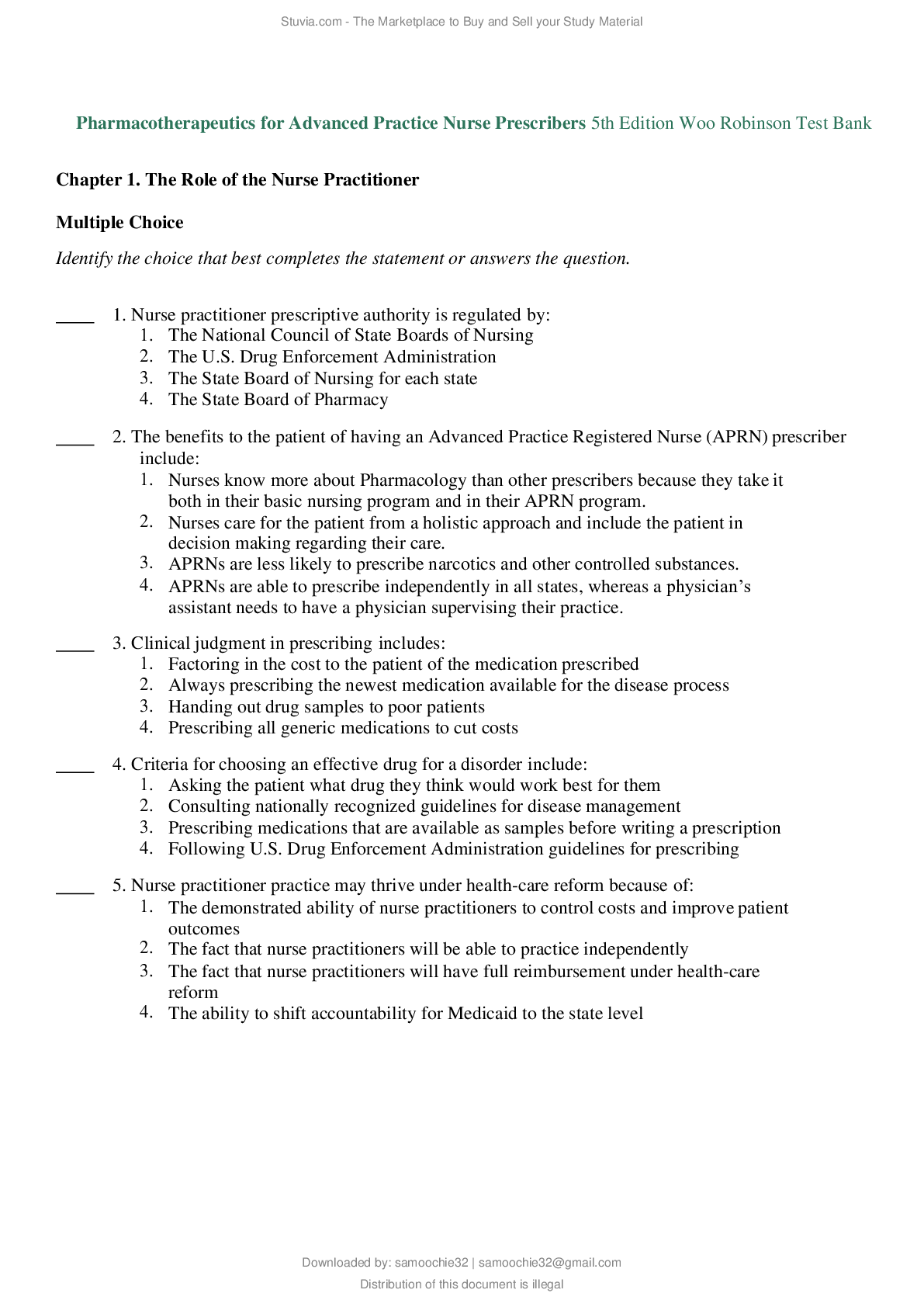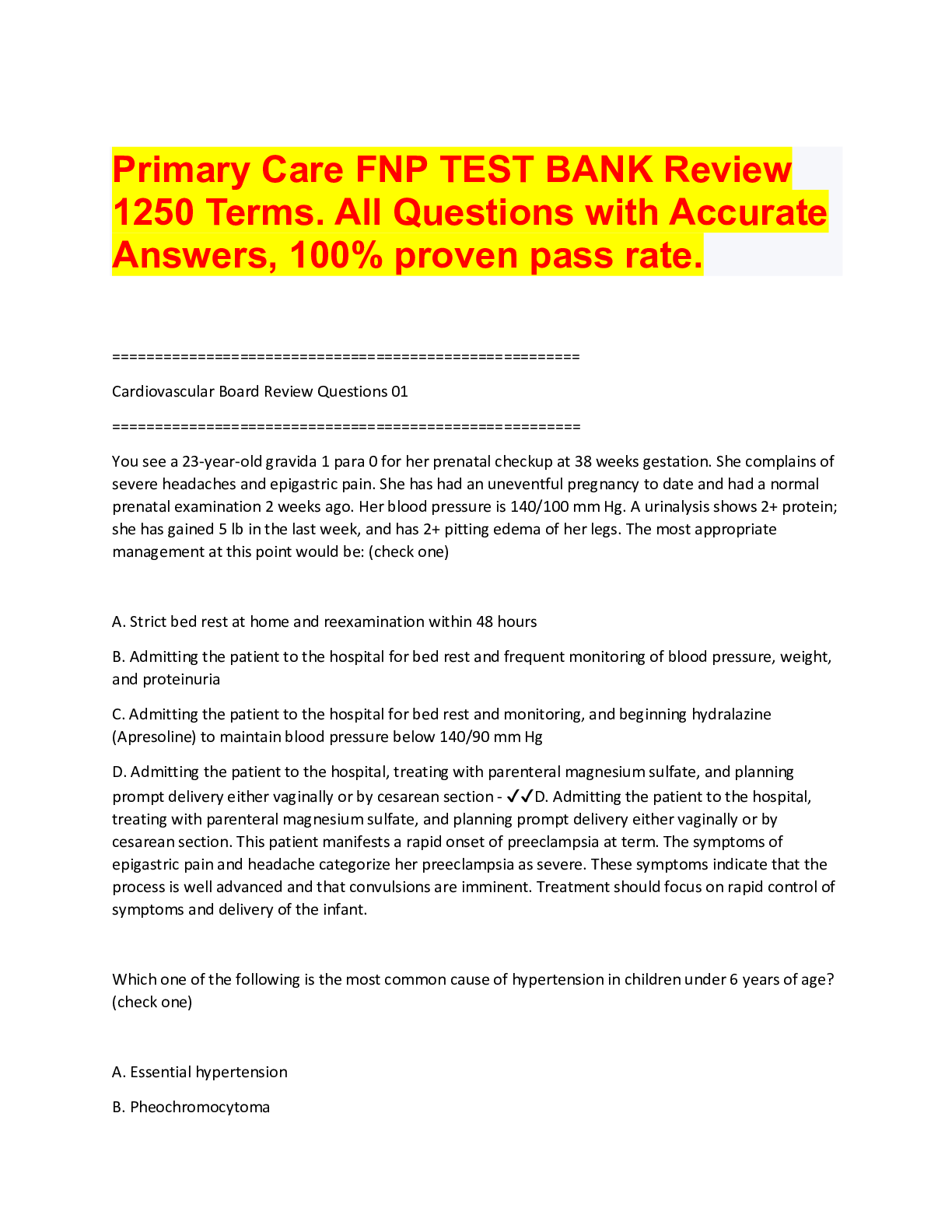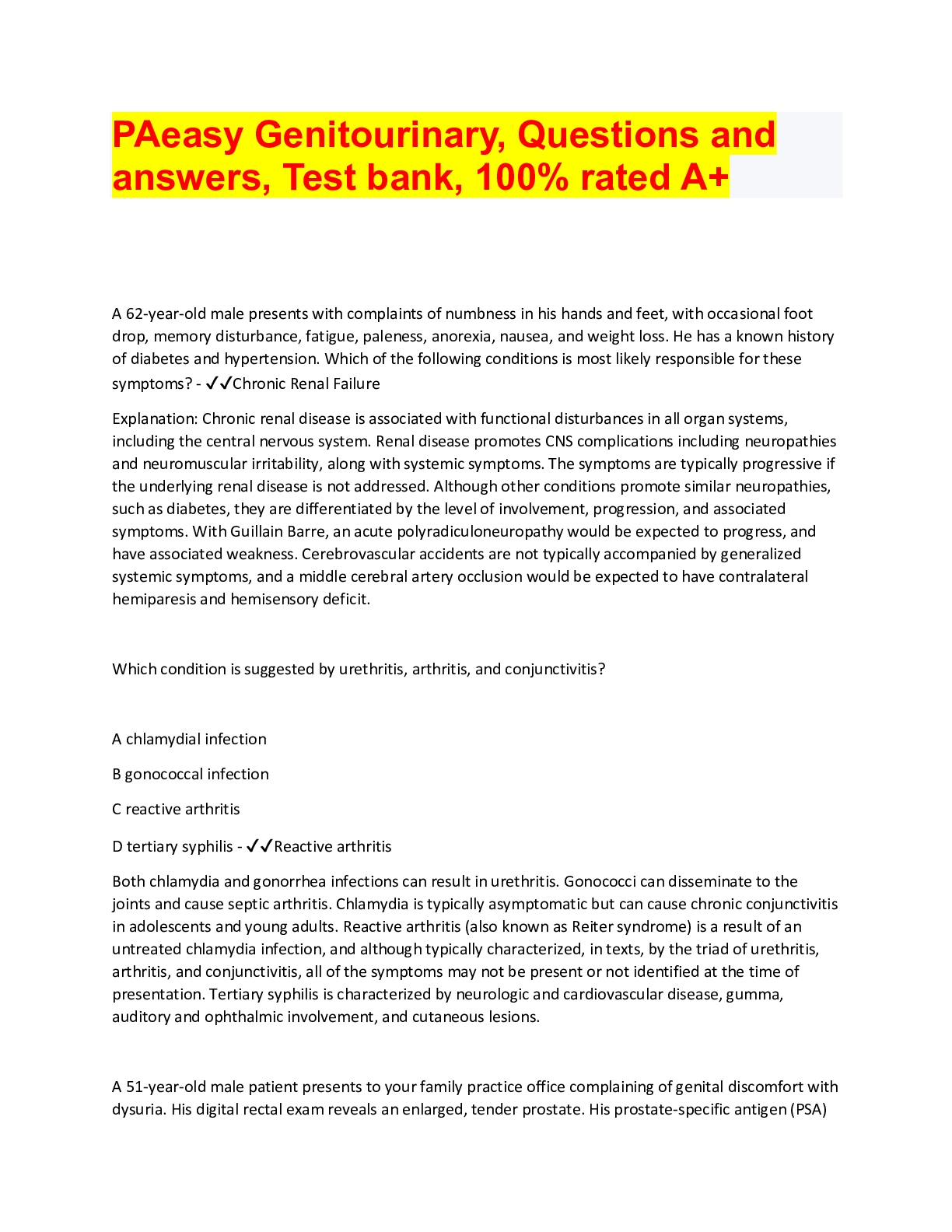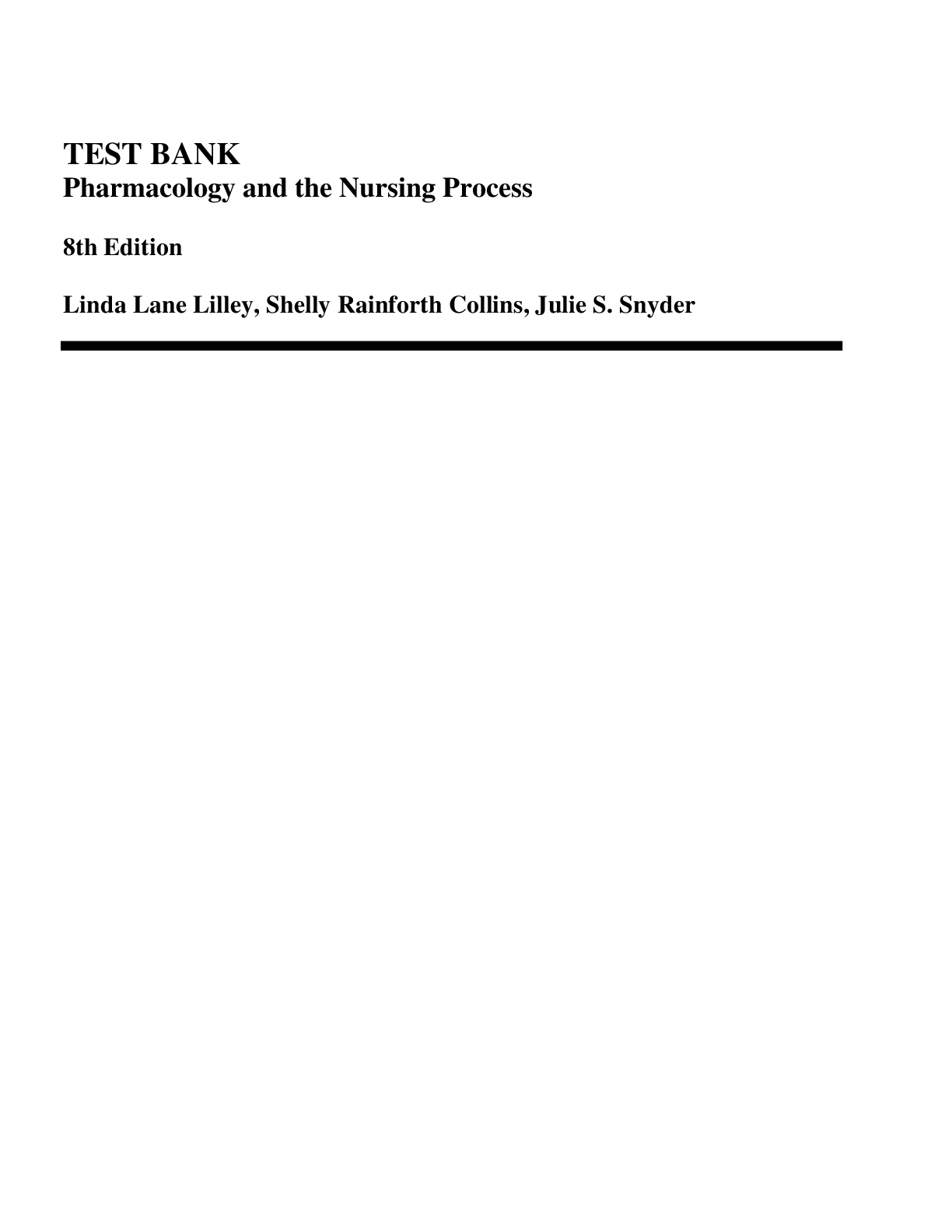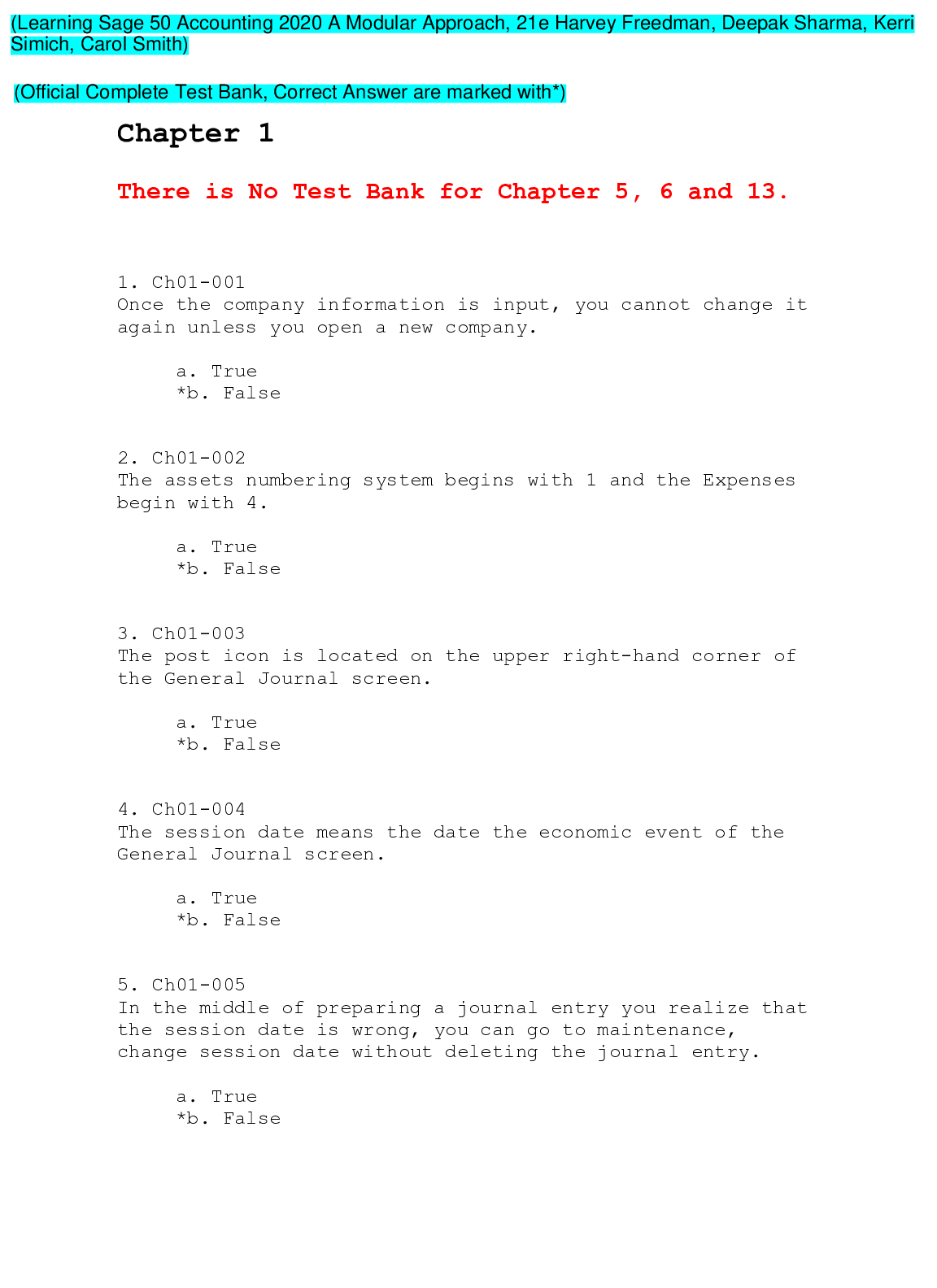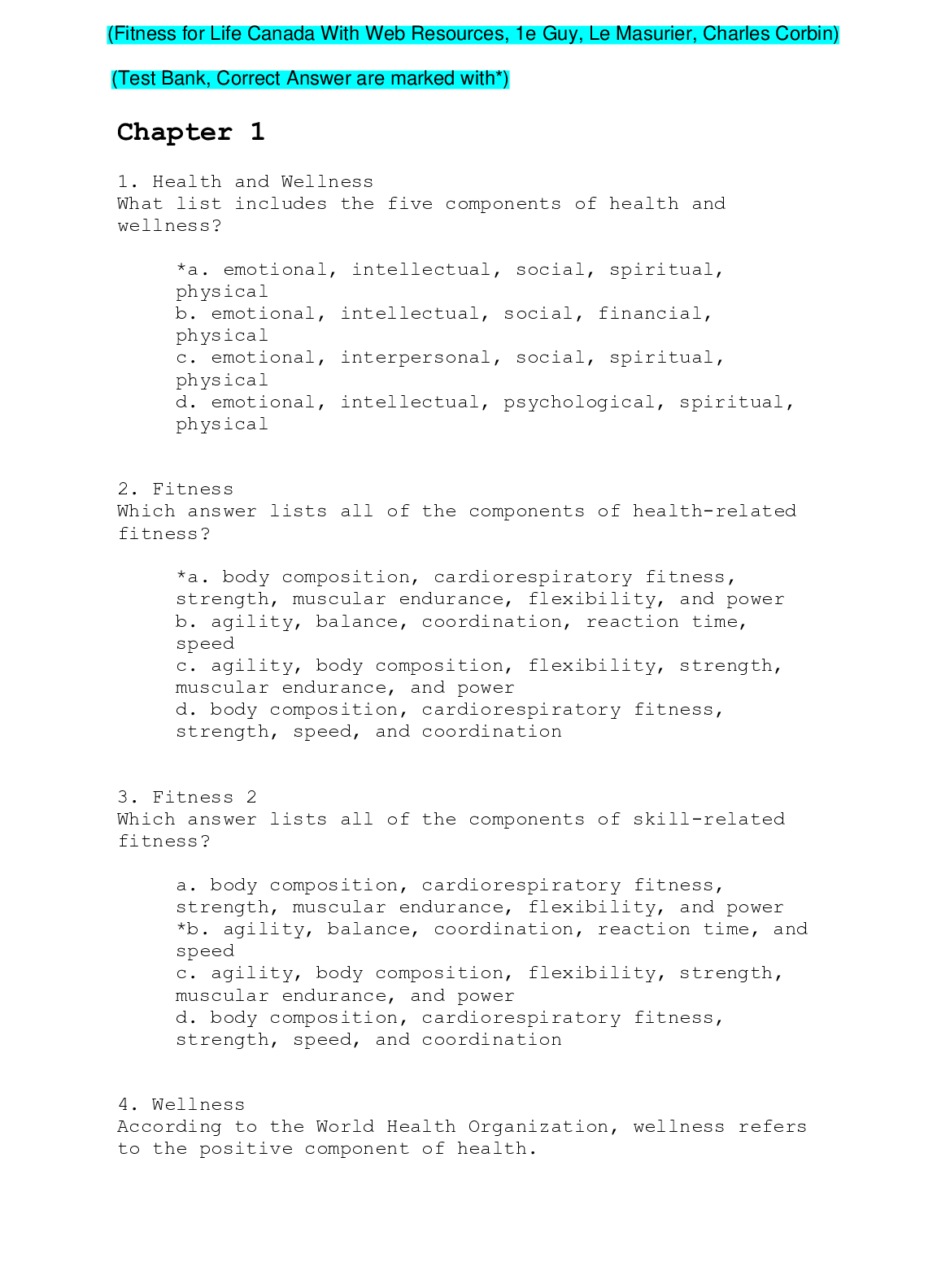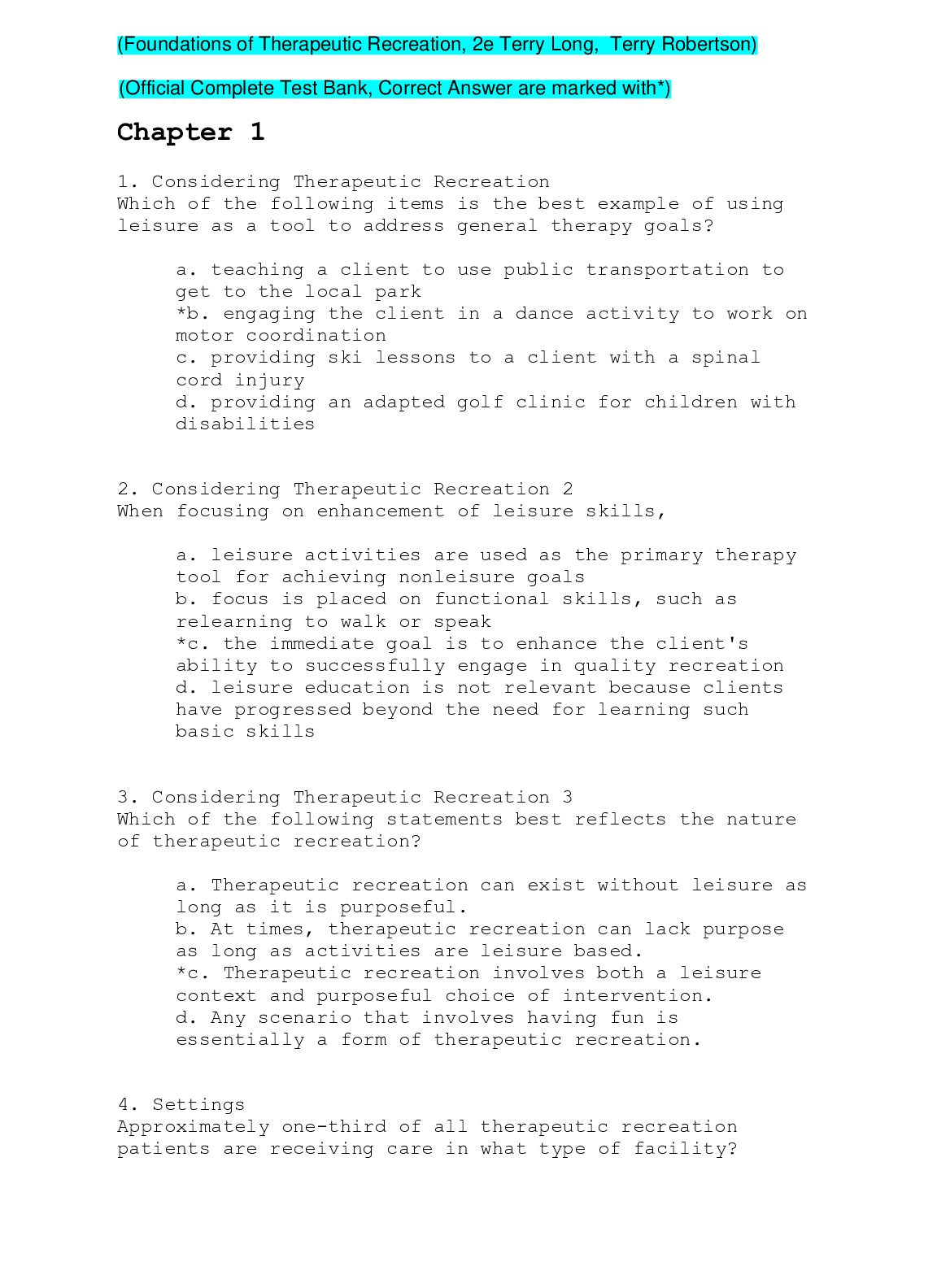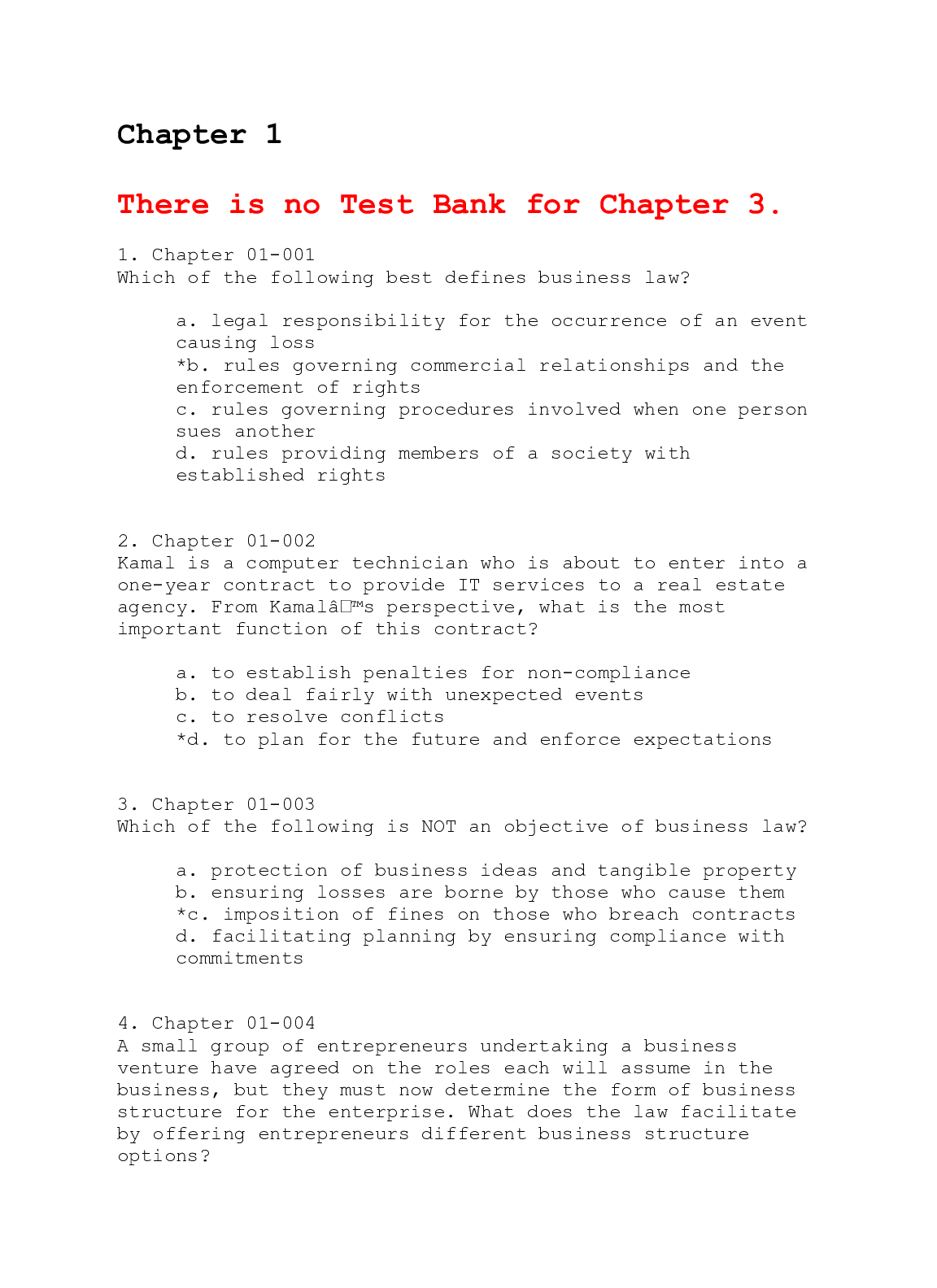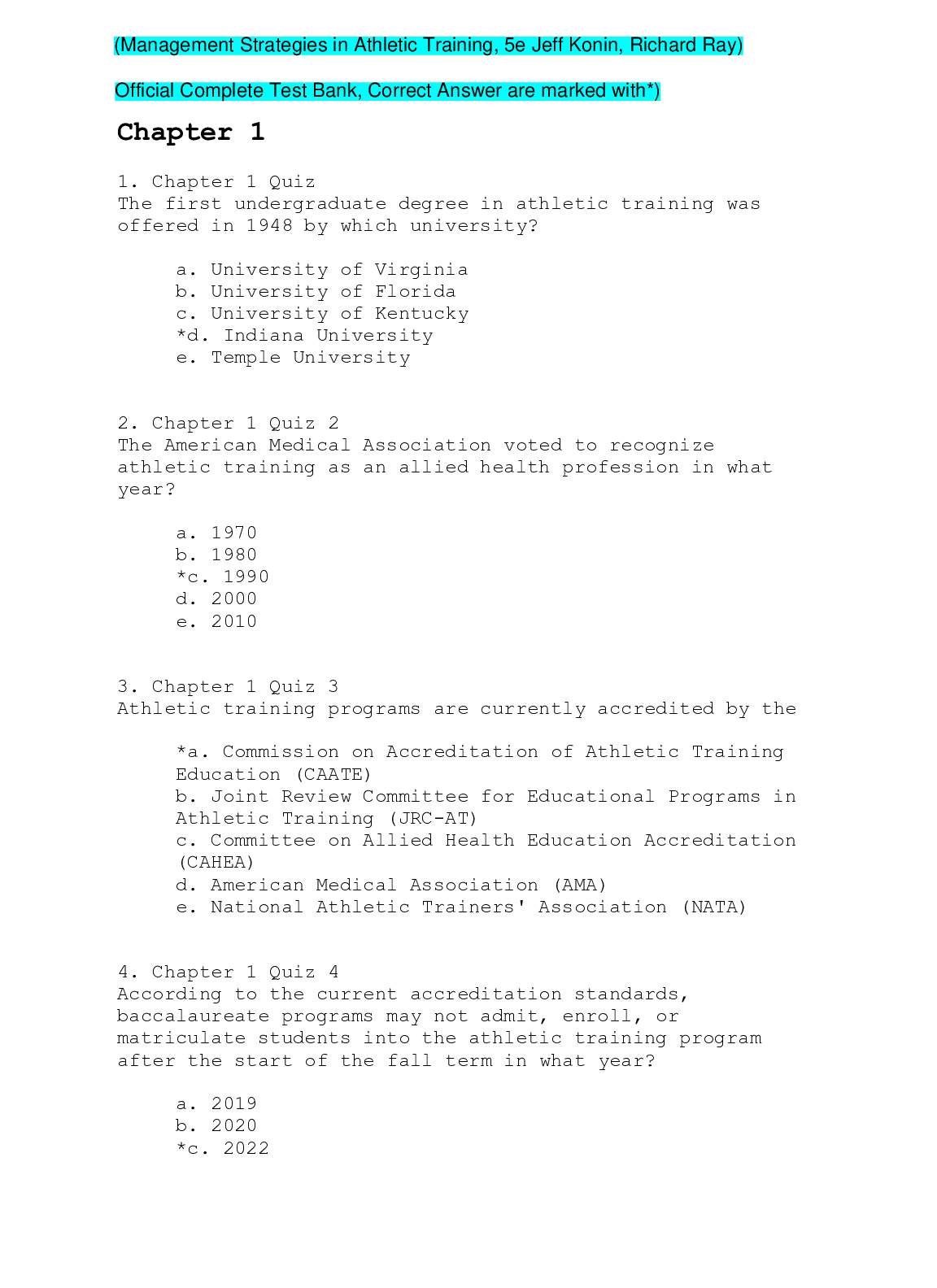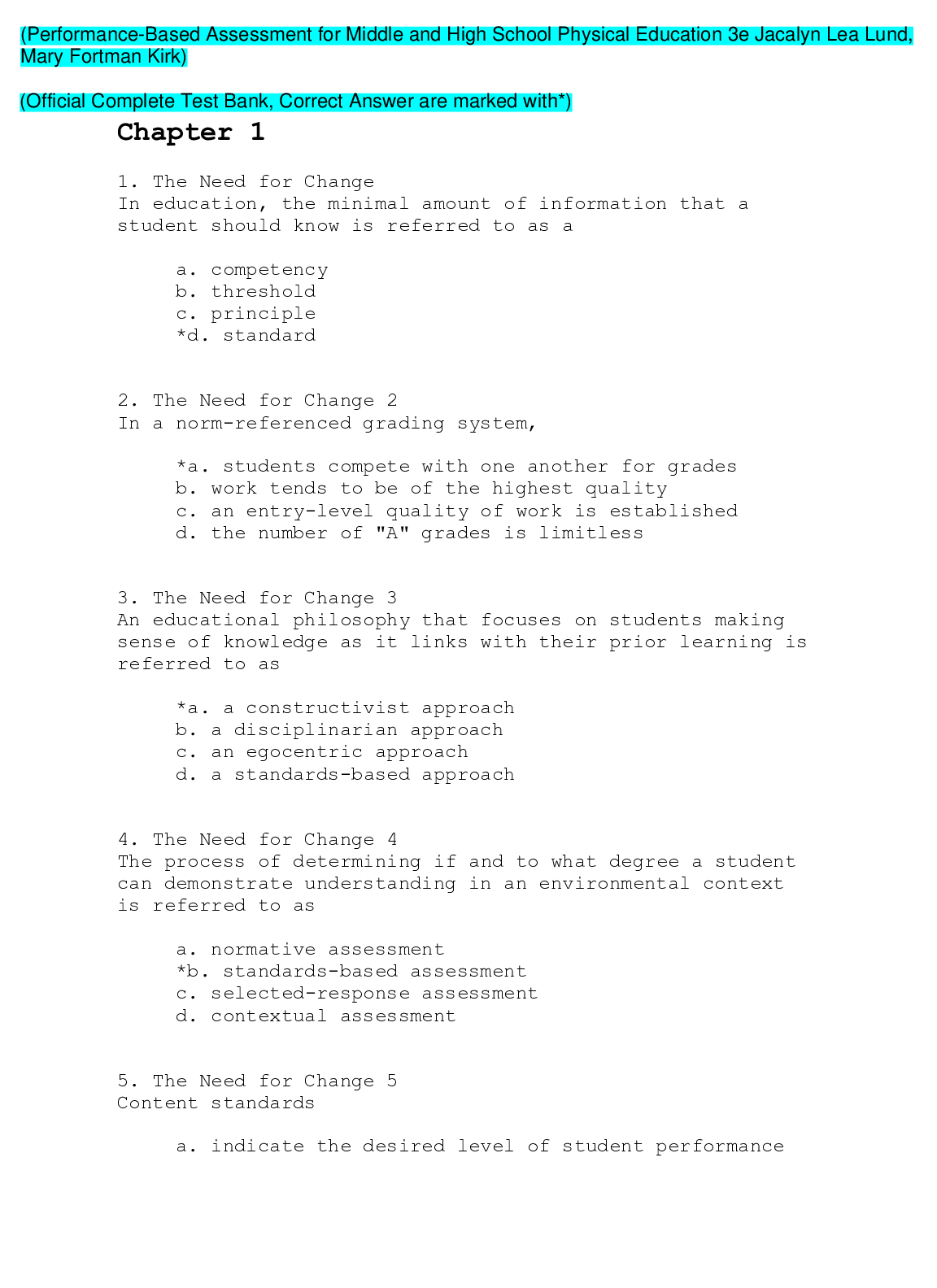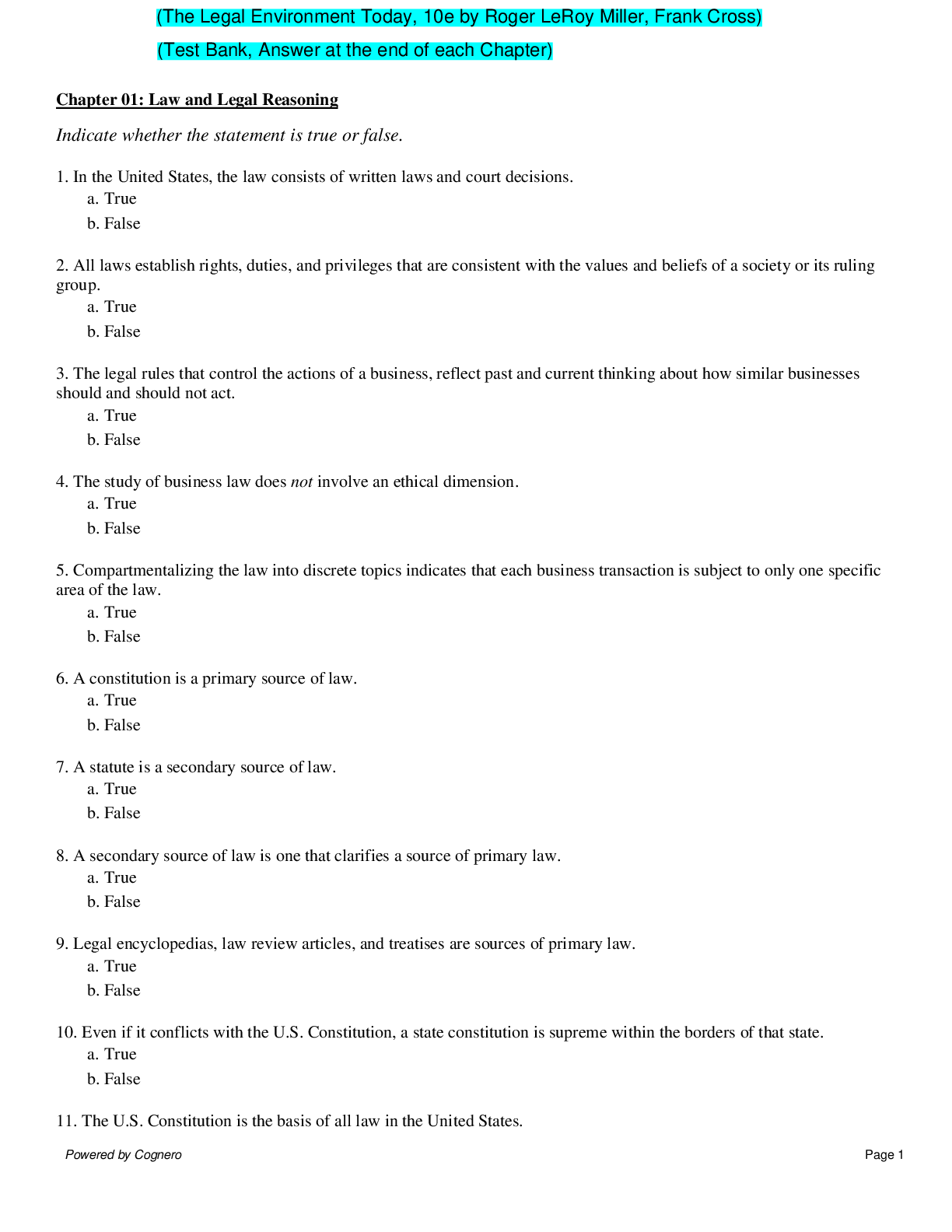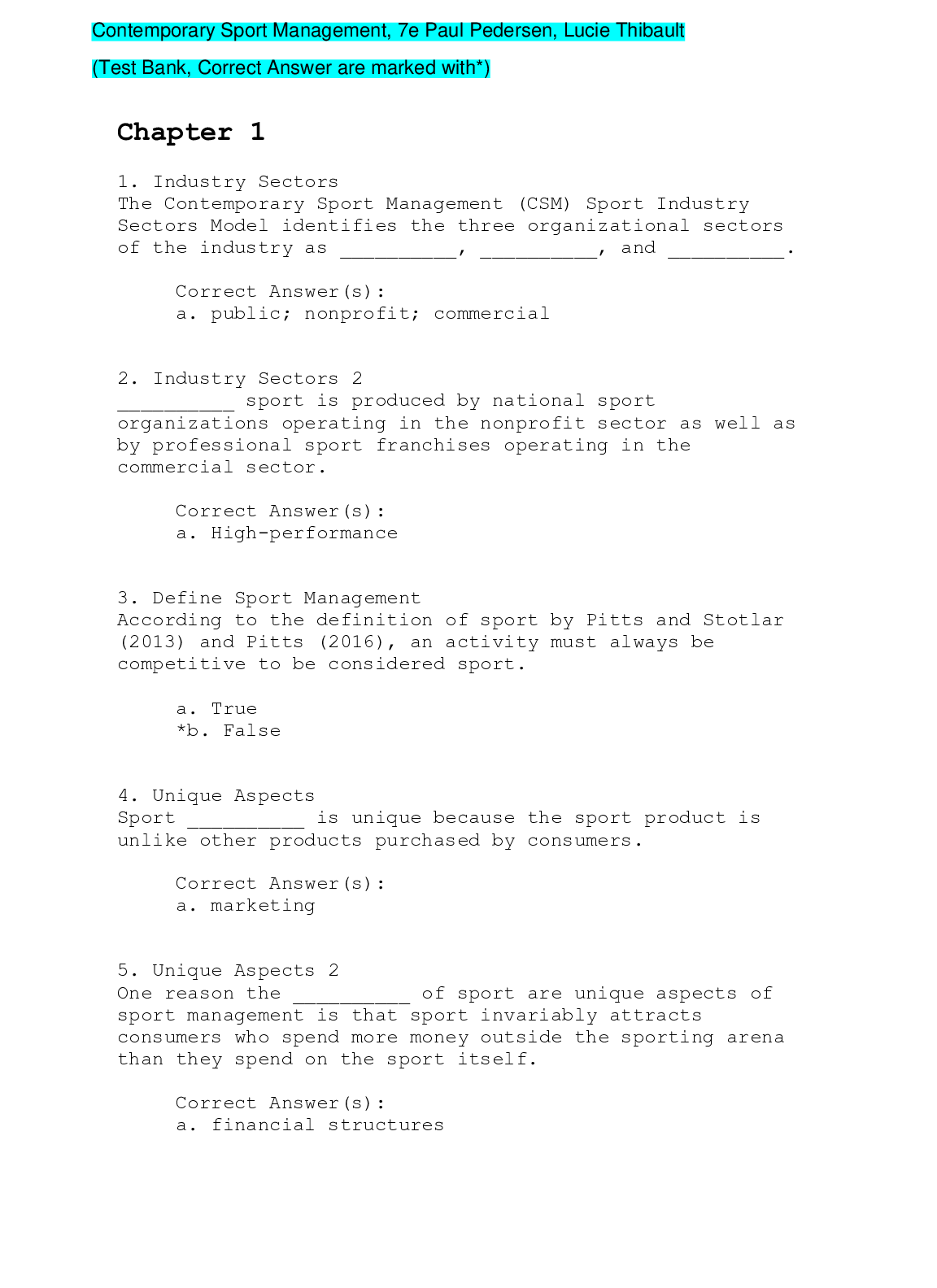The ultimate FISDAP AIRWAY study guide TEST BANK. 100% pass rate.
Document Content and Description Below
The ultimate FISDAP AIRWAY study guide TEST BANK. 100% pass rate. From the atmosphere, what structures does air pass through during ventilation? - ✔✔Starts in atmosphere, then nose, nasoph... aryngeal space/orophargyneal space (if mouth breather), then pharynx, larynx, trachea, bronchi, bronchioles, alveoli What is the purpose of the nasal passages and nasopharynx? - ✔✔To warm/humidify air as it passes through What is the difference between respiration and ventilation? - ✔✔Respiration refers to the exchange of gases in the alveoli, ventilation refers to the movement of air into the lungs. Respiration is needed to provide O2 to cells and remove waste products. Also regulates pH of blood. What are the structures of the upper airway? - ✔✔nose, mouth, tongue, jaw, pharynx and larynx What structure is considered a landmark that divides the upper airway from lower? - ✔✔The larynx, anything above is upper. The larynx and below are lower. What are the structures of the lower airways? - ✔✔larynx (includes adam's apple/thyroid cartilage, cricothyroid membrane, cricoid cartilage), trachea, bronchi, bronchioles, alveoli Describe the anatomy of the larynx. - ✔✔From superior to inferior. Thyroid cartilage, cricothyroid membrane, and cricoid membrane. The thyroid cartilage and cricoid cartilage are anterior to the larynx, and the cricothyroid membrane is posterior to both structures. True or false: the lungs are completely equal in the midsaggital plane. - ✔✔False, right lungs has 3 lobes, left lung only has 2 lobes. Together they have 5 total. Also, the right bronchi is inferior to the left bronchi. What are the structures of the lungs in order of ventilation? - ✔✔bronchioles, and alveoli True or false: the lungs use muscles found in the lateral lobes to expand and contract? - ✔✔False: the lungs are hollow organs and contain no muscles. When the diaphragm contracts it expands the thoracic cavity. The pleural space has a negative pressure and the lungs expand. This results in a slightly negative pressure (compared to the atmosphere) and air rushes in. True or false: Air rushes into the lungs because of negative pressure. - ✔✔True, when the lungs expand, they are creating a vacuum because they are expanding the volume of the container. This increase in volume causes influx of air into the container until the pressure is equalized with the atmosphere. True or false: The parietal pleura lines the lungs and the visceral pleura lines the lungs. The space between is called the anterior pleura. - ✔✔False: the visceral pleura lines the lungs, the parietal pleura lines the body cavity and the pleural space is the space in between both where body fluid allows for both to smoothly glide. What muscles are involved in inhalation? - ✔✔The diaphragm, cervical muscles (neck), intercostals, abdominal muscles, and pectoral muscles. What muscles are involved in expiration? - ✔✔none, expiration (if done passively) is achieved by the relaxation of the diaphragm. What is the primary driver of respiration? (Why would we increase/decrease RR?) - ✔✔The CSF in the brain has chemoreceptors sensitive to CO2. When there is too much CO2. The pH changes. These sensors feed back to the medulla oblongata, which stimulates the phrenic nerve which innervates the diaphragm. They cause an increase in activity of the diaphragm. This increases the RR which causes us to increase tidal volume. This means more CO2 is exhaled. And brings our pH back to normal. We also have the less sensitive hypoxic drive What is hypoxic drive? - ✔✔Backup system to control respiration. Chemoreceptors in brain, aorta, and carotid arteries. But they are "satisfied" by a small amount of O2, which means it is not as sensitive as pH control of CO2 What two areas of the brain are involved in respiration? - ✔✔medulla-controls rhythm, initiates inspiration, sets base pattern for respirations, and stimulates diaphragm to contract. pons-changes depth of inspiration, expiration or both. True or false: arteries bring oxygenated blood to organs/capillaries - ✔✔True in most cases with one exception. Arteries (away) bring blood away from the heart. Usually this is oxygenated blood. But the pulmonary arteries bring oxygen poor blood away from the heart, to the lungs to be oxygenated. What is the tidal volume? - ✔✔amount of air moved in/out of lungs in single breath. Usually 500 ml in adult What is inspiratory reserve volume? - ✔✔Deepest breath you can take after normal respiration What is expiratory reserve volume/Vital Capacity? - ✔✔maximum amount you can breathe out after normal breath. What is residual volume? - ✔✔Remaining gas in lungs after exhalation. This is to keep lungs inflated What is dead space? What structures are considered part of dead space? - ✔✔Part of respiratory system not involved in active respiration. Air moves through here but little to no respiration occurs. Mouth, trachea, bronchi and bronchioles considered dead space What is minute volume? What does it measure? - ✔✔Minute volume = RR x tidal volume. Volume of air moving through lungs in 1 minute. Can be estimated quickly. Count RR rate. If normal check to see chest rise and fall (tidal volume). If chest rise and fall is weak and/or little air coming out of nose, then the person has small minute volume. Alveolar Minute Volume - ✔✔Volume of air moved through lungs in 1 minute minus the dead space. Alveolar Minute Volume = (tidal volume - dead space) x RR Alveolar Ventilation - ✔✔Volume of air that reaches alveoli. Alveolar ventilation = tidal volume - dead space Name the characteristics of normal breathing - ✔✔1. Normal rate (12-20) 2. regular pattern of inhalation/exhalation 3. clear bilateral lung sounds 4. regular and equal chest rise/fall 5. adequate depth (tidal volume) What are the characteristics of inadequate breathing (adults)? - ✔✔Chapter 6 1. labored breathing (activating accessory muscles of respiration) 2. 12< or >20 breaths/minute 3. muscle retractions above clavicles or between ribs and below rib cage 4. pale/cyanotic skin 5. cool, damp, clammy skin 6. tripod position Chapter 10 1. 12< or 20> 2. irregular rhythm 3. diminished, absent or noisy auscultated breath sounds 4. reduced flow of expired air at nose/mouth 5. unequal or inadequate chest expansion 6. labored breathing 7. shallow depth 8. pale, cyanotic, cool or moist skin 9. retractions around ribs or above clavicles What are agonal gasps? What should you do if a pt has agonal gasps? - ✔✔Pt in cardiac arrest has occasional gasping breaths because respiratory center in brain continues to send signals to breathing muscles. Artificial ventilations and chest compressions. Where are the alpha-1 receptors located? What is their effect? - ✔✔location-blood vessels constricted blood vessels, skin is pale, cool, clammy They essentially increase BP Where are the Beta-1 receptors located? What is their effect? - ✔✔location-heart effect- increased HR, increased force of contraction They essentially increase CO since CO = HR x SV Where are the Beta-2 receptors located? What is their effect? - ✔✔location - lungs (beta-2 is beta-tube) effect - bronchodilation (more air enters lungs) Where are the muscarinic receptors located? What is their effect? - ✔✔location - heart effect - decreased HR, decreased force of contraction Muscarinic is parasympathetic system and do complete opposite of Beta-1 which is sympathetic What hormones activate the sympathetic nervous system? - ✔✔Epineprhine and norepineprhine, which are released from he adrenal gland after stimulation by the sympathetic nervous system. These hormones stimulate heart and blood vessels. What is pathophysiology? - ✔✔Study of how normal physiologic processes are affected by disease What is respiratory compromise? - ✔✔Inability of body to move gas effectively. Can result in decreased O2 (hypoxia) and increased CO2 (hypercarbia) What factors can impair ventilation? - ✔✔1. Obstruction a. foreign objects - toys, food, teeth tongue etc b. physiological - induced by asthma, allergic rxns, infection 2. Impairment a. brain injury - to medulla/pons b. breathing muscles - diaphragm, c. nerves - neuromuscular disease like cerebral palsy can affect phrenic nerve 3. Other factors a. drugs - opioids can reduce RR b. loss of consciousness - can cause impaired ventilation c. trauma to chest wall - impair expansion of lungs What factors can impair respiration? - ✔✔1. air (too little O2, too much CO2, toxins like CO) 2. impaired movement of gas across cell membrane (due to fluid in alveoli, mucus or other secretions) 3. Blood vessels become clogged (pulmonary embolism) What is the V/Q ratio? - ✔✔How much gas is being moved effectively, versus how much blood is flowing around the alveoli where gas exchange (perfusion occurs) example - pt w/ pulmonary embolism might have regular ventilation, but blockage might impair exchange or perfusion. So Q is compromised. What happens in the body when there is respiratory compromise? - ✔✔1. O2 levels fall and CO2 levels rise 2. Brain detects increase in CO2 3. Body increases RR to try to manage CO2 levels 4. If increased respiration does not clear CO2, then blood is acidic 5. Blood o2 levels begin to fall, activating hypoxic drive 6. Cells that are able switch to anaerobic metabolism, producing lactic acid which further drops pH Glottis - ✔✔Space between vocal cords and narrowest portion of adult's airway. Lateral borders of glottis are the vocal cords. They contain defense reflexes that protect lower airway, and spasm to prevent foreign substances from entering trachea Carina - ✔✔The branching area of the left and right bronchi Mediastinum - ✔✔Area between the lungs which is surrounded by tough connective tissue. Contains heart, great vessels, esophagus, trachea, major bronchi and nerves. What is the term used to describe the amount of gas in air or dissolved in fluid? How is this relevant to ventilation? How is this relevant to respiration? - ✔✔Partial pressure of gas, measured in mmHg. When lungs expand, partial pressure of air is less than that in atmosphere. Air rushes in during ventilation. Inhalation In oxygen rich lungs, PO2 > PO2 oxygen poor blood. O2 diffuses across alveoli into blood. In CO2 rich blood, PCO2 > PCO2 of lungs so CO2 diffuses from blood to lungs, and then is exhaled out What does it mean if someone says they are "keeping the airways patent"? - ✔✔Keeping airway patent = maintaining open airway so air can enter/leave lungs freely How is regulation of breathing different in those with COPD? What does research indicate about assisting in respiration with COPD sufferers? - ✔✔COPD sufferers have difficulty removing CO2 from body. Overtime, respiratory control centers in brain adjust to this new baseline of CO2. In late stage COPD hypoxic drive is activated. Some research suggests that providing high flow O2 could negatively affect body's drive to breathe. What is Dyspnea? - ✔✔Shortness of breath Signs and symptoms of Hypoxia? - ✔✔Early 1. Restlessness 2. Irritability 3. apprehension 4. tachycardia 5. anxiety Late 1. mental status changes 2. weak (thready) pulse 3. cyanosis 4. Dyspnea Cellular respiration (Metabolism)? - ✔✔Cells take energy from nutrients through series of chemical processes. What is the difference between external and internal respiration? - ✔✔External - process of breathing fresh air into respiratory system and exchanging O2 and CO2 between alveoli and blood in pulmonary capillaries internal - exchange of oxygen and CO2 between systemic circulatory systems and cells of body What are the critical periods in which a cell needs O2? - ✔✔0-1 minute: cardiac irritability 0-4 minute: brain damage not likely 4-6 minute: brain damage possible 6-10 minute: brain damage likely more than 10: irreversible brain damage What is intrapulmonary shunting? What is the cause of it? - ✔✔It's when blood enters lungs from right side of heart bypasses alveoli and return to left side of heart in unoxygenated state. Can be caused by nonfunctional alveoli due to diseases What factors can lead to hypoxia due to circulatory compromise? - ✔✔1. obstruction of blood flow due to a. pulmonary embolism b. pneumothorax c. heart failure d. cardiac tamponade 2. Decreased ability of blood to carry O2 a. blood loss b. anemia c. shock (vasodilatory shock) What is labored breathing? How do you tell someone has it? - ✔✔Pt with inadequate breathing may appear to be working hard to breathe. Look for use of accessory muscles which are not used during normal breathing What are Cheyne-Stokes Respirations? What do they indicate? - ✔✔Irregular respiration where pt breathes w/ increasing rate/depth that is followed by apnea, followed again by period of increasing rate/depth of respiration. Can occur in people with strokes/head trauma What are ataxic respirations? - ✔✔When pt has irregular ineffective respirations that may or may not have identifiable pattern What are Kussmaul respirations? What do they indicate? - ✔✔Deep, rapid respirations Seen in pt's with metabolic acidosis, or those with diabetes You arrive on scene with a pt that is conscious but experiencing respiratory distress. What are two devices that can assess their respiration? - ✔✔1. Pulse oximetry (measures O2 bound to hemoglobin) 2. Capnography device (measures end tidal CO2) How would you use a pulse oximeter? - ✔✔1. clean pt's finger, and remove nail polish as needed. Place finger into probe and turn on. 2. Palpate radial pulse to ensure accuracy and correlation w/ pulse ox Normal reading between 98-100. Less than 90% pt requires treatment unless chronic condition. Oxygen applied when SPO2 drops below 94% What can cause an inaccurate pulse ox? - ✔✔1. Hypovolemia 2. Severe peripheral vasoconstriction (chronic hypoxia, smoking or hypothermia) 3. Time delay in detecting respiratory insufficiency 4. Dark/metallic nail polish 5. Dirty fingers 6. CO poisoning You encounter an unconscious pt. They have a pulse but inadequate breathing. What should you do if they are a) found in their bed or b) found underneath a tree? - ✔✔You need to open the airway. If head trauma is suspected, use a jaw thrust. If head trauma is not suspected, use a head-tilt-chin-lift maneuver You encounter an unconscious pt. They have a pulse but inadequate respirations. You open the airway and find vomit. What should you do? - ✔✔You should suction the pt using How do you use suction equipment? - ✔✔Can use rigid (Yankauer/tonsil tips) or nonrigid (french/whistle-tip). Use rigid unless you are suctioning a stoma or suctioning nose/liquid at back of mouth. Make sure to measure for proper size. Don't touch back of throat, don't want to activate gag reflex. Turn on to at least 300 mmHg. Attach appropriate tubing. Suction for no more than 15 seconds for adults, 10 seconds for children, and 5 seconds for infants. Rinse with water. Asthma - ✔✔1. wheezing on expiration* 2. Bronchospasm 3. Cyanosis and or resp arrest can develop quickly Anaphylaxis - ✔✔1. Flushed skin/hives (urticaria) 2. Generalized edema 3. hypotension 4. laryngeal edema w/ dyspnea 5. wheezing/stridor Most rxns occur w/in 30 mins, administer epi using epipen. O2 also helps Bronchiolitis - ✔✔1. Dyspnea 2. wheezing 3. Coughing 4. fever 5. dehydration 6. Tachypnea 7. Tachycardia - Often due to RSV infection* -severe bronchiole inflammation* - Occurs most frequently in infants, especially boys* -Provide O2 therapy, allow pt to remain in comfortable position - Reassess frequently and be prepared to manage airway/positive pressure ventilation Bronchitis - ✔✔1. Chronic cough w/ sputum production 2. Wheezing 3. cyanosis 4. Tachypnea Type of COPD, can be due to tobacco. When excess mucus created. Carbon Monoxide Poisoning - ✔✔1. flu like symptoms* 2. headache 3. dizziness 4. fatigue 5. nausea 6 . vomiting 7. chest pain on exertion 8. Confusion/hallucination - remove them from scene, administer high flow o2 by nonrebreathing mask - May need full airway control w/ airway adjunct and bvm ventilation CHF - ✔✔1. Dependent edema 2. Crackles (pulmonary edema) 3. Orthopnea 4. Paroxysmal nocturnal dyspnea 5. JVD - risk factors: HTN, CAD, AFib - most common cause of ER visits Common Cold - ✔✔1. cough 2. runny/stuffy nose 3. sore throat COPD - ✔✔- smokers* - chronic inflammatory lung disease that causes obstructed airflow from the lungs - breathing difficulty; pursed lips* - chronic cough - mucus (sputum) production - wheezing* - Hypoxic drive frequently found - 3rd leading cause of death Croup - ✔✔1. fever 2. barking cough 3. stridor 4. mostly seen in pediatric patients inflammation/swelling of pharynx, larynx and trachea. Typically seen in young children Treat w/ humidified O2 Diphtheria - ✔✔1. difficulty breathing/swallowing 2. sore throat 3. thick gray buildup in throat/nose 4. fever Emphysema - ✔✔1. barrel chest 2. pursed lip breathing (pink puffers) 3. dyspnea on exertion 4. cyanosis 5. wheezing/decreased breath sounds Most common form of COPD. Loss of elastic material in lungs Epiglottitis - ✔✔1. Dyspnea 2. High fever 3. stridor 4. drooling 5. difficulty swallowing 6. severe sore throat 7. tripod/sniffing position Life threatening, caused by bacterial infection of epiglottis in children, risk of complete airway obstruction. Try to keep them from crying. Do not put anything in mouths. Provide quick transport to ER, focus on maintaining patent airway Flu - ✔✔1. cough 2. fever 3. sore throat 4. fatigue Hay fever (allergic rhinitis) - ✔✔- coldlike symptoms, caused by allergic response (pollen, dust mites, pet dander etc) - pt likely has other allergies Hyperventilation - ✔✔over breathing to the point of arterial CO2 falls below normal. Alkalosis of blood occurs. 1. anxiety* 2. dizziness* 3. numbness 4. tingling of hands/feet* 5. painful spasms of hand/feet 6. Pt's feel they cannot catch breathe - Hyperventilation syndrome occurs when someone experiences psychological distress -Maybe be as high as 40 breaths/min or low as 20. Verbally instruct pt to slow breathing, and if that doesn't work, give supplemental O2 and provide transport Pertussis - ✔✔1. coughing spells 2. whooping sound* (insp) 3. fever - airborne bacterial infection, highly contagious - affects kids 6 & under - coughing spells can last for a minute where pt turns red - May vomit/want to avoid eat/drink Pleural Effusion - ✔✔collection of fluid outside lung on one or both sides that compresses lung/lungs and causes dyspnea. Lung sounds = decreased breath sounds from lungs where fluid is. Pt's feel better sitting upright, but only treatment is fluid removal in hospital Pneumonia - ✔✔1. dyspnea 2. chills/fever 3. cough 4. green, red or rust colored sputum* 5. localized wheezing or crackles - Infection of lungs, often secondary infection - Affects people who are chronically/terminally ill (nursing home, hospitalization, chemo, COPD etc.) - May hear wheezing, crackles, friction rubs or rhonchi. Provide airway support, supplemental O2 pneumothorax - ✔✔1. sudden chest pain w/ dyspnea 2. decreased breath sounds on affected side 3. subcutaneous emphysema 4. JVD Effects tall and thin people more. Caused when air leaks into pleural space from opening in chest/lung surface. Lung collapses and pleural spaces no longer contact Pulmonary edema - ✔✔caused by CHF, where heart can't pump blood away as fast as it collects in pulmonary arteries. So you have edema in lungs. 1. difficulty breathing w/ exertion 2. sudden attack of respiratory distress 3. suffocation feeling 4. cold sweats 5. tachycardia 6. cool, diaphoretic, cyanotic kin 7. adventitious breath sounds like crackles/wheezing 8. tachycardia 9. hypertension initially then hypotension Pulmonary Embolus - ✔✔1. sharp chest pain* 2. sudden onset* 3. dyspnea* 4. tachycardia 5. clear breath sounds initially 6. hemoptysis (coughing up blood)* 7. tachypnea Tension Pneumothorax - ✔✔1. severe shortness of breath 2. decreased/altered level of consciousness 3. neck vein distension 4. tracheal deviation (late sign) 5. hypotension, signs of shock (late sign) Respiratory syncytial Virus (RSV) - ✔✔1. cough 2. wheezing 3. fever 4. dehydration Look for signs of dehydration, infants w/ RSV often refuse liquids. Humidified O2 can be helpful TB - ✔✔1. cough 2. fever* 3. fatigue* 4. productive/bloody sputum* 5. Night sweats/weight loss - bacterial infection, can be dormant for years - High prevalence for people living in close contact (prison, nursing homes, homeless shelters) - Need to wear gloves, eye protection, N-95 respirator How would you differentiate COPD and CHF? - ✔✔COPD emphysema - thin w/ barrel chest, pink puffer, tripod position, flat neck veins, dry lungs, shortness of breath on exertion, rhonchi, wheezing, no mucus bronchitis - obese, difficulty w/ expiration, flat neck veins, blue bloat, lungs wet, shortness of breath on exertion, rhonchi, wheezing, frequent/chronic cough, excessive thick mucous CHF - abdominal distention, edema (sacral/pedal), tachycardia, increased RR, anxiety, inability to lie flat, cyanotic, confused LOC, blue skin, wet lungs, shortness of breath all the time, sudden onset of shortness, crackles, wheezing, coughing may be present, pink frothy sputum What are the types of normal breath sounds? - ✔✔1. Vesicular 2. Bronchol-vesicular 3. Bronchial (tubular) What are vesicular breath sounds? - ✔✔description - soft pitched, low intensity gentle sighing location - over peripheral lung, best heard at base characteristics - best heard on inspiration (5:2) ratio What are bronchiole-vesicular sounds? - ✔✔description - moderate intensity and moderate pitch blowing sounds, created by air moving through larger bronchi location - between scapula and lateral to sternum characteristics - equal inspiratory and expiratory What are bronchial (tubular) lung sounds? - ✔✔description - high pitched, loud harsh sounds created by air moving through trachea location - anteriorly over trachea, generally not heard over lung tissue characteristics - louder than vesicular sounds, have short inspiratory phase and long expiratory phase (1:2 ratio) What are the types of adventitious lung sounds? - ✔✔1. crackles (rales) 2. gurgles (rhonchi) 3. friction rub 4. wheeze 5. stridor What are crackles? - ✔✔description - fine short, interrupted crackling sounds, best approximated by rolling hair between fingers. Best heard on inspiration but can be heard on both. May not be cleared by coughing cause - air passing through fluid/mucous in air passageway location - most often heard in lower lung lobes associated w/ - pulmonary edema, CHF, pneumonia, pulmonary fibrosis, bronchitis What are gurgles (rhonchi)? - ✔✔description - continuous low pitched gurgling sounds w/ moaning/snoring quality. Best heard on inspiration but can be heard on both. Can be altered by coughing. cause - Air passing through narrowed air passages as a result of secretions, swelling, tumors location - Loud sounds can be heard over most lung areas, but predominate over the trachea and bronchi associated w/- Secretions, Obstructions, Pneumonia, Bronchitis, COPD Friction rub - ✔✔description - Superficial grating or creaking sounds heard during inspiration and expiration. Not relieved by coughing. cause - Rubbing together of inflamed pleural surfaces location - Heard most often in areas of greatest thoracic expansion (e.g., lower anterior and lateral chest) associated w/ - Pleuritis, Pulmonary embolism, COPD, Pneumonia Wheeze - ✔✔description - Continuous, high-pitched, squeaky musical sounds. Best heard on expiration. Not usually altered by coughing. cause - Air passing through a constricted bronchus as a result of secretions, swelling, tumors location - Heard over all lung fields associated w/ - Asthma, Allergic reaction, Airway obstruction, COPD Stridor - ✔✔description - A harsh vibrating noise when breathing, caused by obstruction of the windpipe or larynx. cause - Obstruction or narrowing of the upper airway. location - Less than severe stridor can be auscultated over the larynx. Severe stridor can be heard without a stethoscope. associated w/ - Obstruction in Larynx, Obstruction in Trachea, Croup, Epiglottitis Laryngeal edema What are the two purposes of inserting an OPA? - ✔✔1. lift the tongue 2. Make it easier to suction oropharynx Indications/contraindications for OPA? - ✔✔Indications a. unresponsive pt's w/o gag reflex b. any apneic pt ventilated w/ a BVM Contraindications a. conscious pt's b. any pt (conscious or unconscious) w/ gag reflex Indications/contraindications for NPA? - ✔✔indications a. semiconscious/unconscious pt w/ intact gag reflex b. pat's who otherwise will not tolerate OPA contraindications a. severe head injury w/ blood draining from nose b. history of fractured nasal bone What is the recovery position? - ✔✔used to help maintain clear airway in unconscious pt who is not injured and is breathing on his or her own w/ normal respiratory rate and adequate tidal volume Bag Valve Mask - ✔✔use w/ or w/o oxygen. Use for pt's in respiratory arrest, cardiopulmonary arrest, and respiratory failure. A 13 year old female watching a horror movie states she can't catch her breath and her fingers are numb. Respirations are 30 and deep with Sp02 of %100. She is speaking in clear sentences, has clear and equal breath sounds. You should? - ✔✔Calmly reassure her, encouraging her to calmly slow her rate of breathing. (She is hyperventilating. Only treatment is to attempt to calm the patient) You have inserted an OPA for a 21 year old apneic male. How many times per minute should you ventilate him with a BVM? - ✔✔10 to 12 Proper technique to suction patient's airway includes? - ✔✔Oxygenating and ventilating before and after suctioning. Cannot exceed more than 30 seconds between ventilations. So when administering adjunct, oxygen, and mask delivery, you must complete administration before the 30 seconds are up. Which patient would be classified as "immediate" during and MCI? - ✔✔8 year old female with no respirations after 5 positive pressure ventilations. When ventilating patient with BVM, what is the appropriate oxygen flow rate? - ✔✔15 liters/min (15 - 25(max) L/m) An obese man complains of sever difficulty breathing. His skin is cool and moist and breathing 22 times per minute. He indicates he never goes to the doctor and often feels dizzy after walking. You should? - ✔✔Apply a nonrebreather mask at 10 liters/min A 42 year old asthmatic patient complains of chest pain, shortness of breath and a violent cough that produces brownish sputum. What is the most likely cause? - ✔✔Pneumonia An 89 year old patient complains of difficulty breathing and a productive cough that has gotten worse over the past 12 hours. You should suspect? - ✔✔Pneumonia As the diaphragm relaxes, the intercostal muscles and the chest cavity? - ✔✔Chest Cavity decreases in size. Diaphragm relaxes and moves upward into chest cavity and the intercostal muscles relax pulling ribs back into neutral position decreasing the size of the chest cavity. [Show More]
Last updated: 11 months ago
Preview 1 out of 132 pages
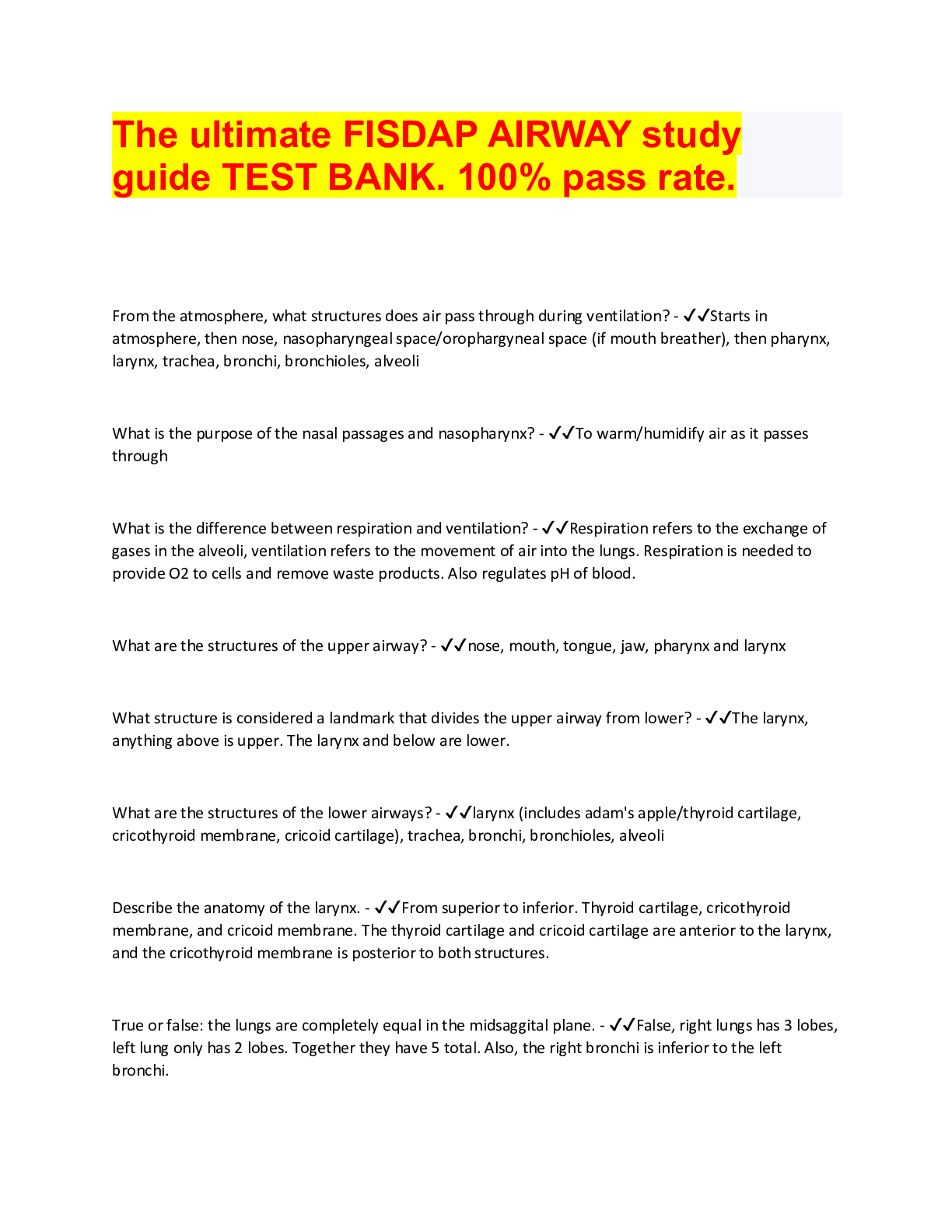
Reviews( 0 )
Document information
Connected school, study & course
About the document
Uploaded On
Aug 24, 2022
Number of pages
132
Written in
Additional information
This document has been written for:
Uploaded
Aug 24, 2022
Downloads
0
Views
73






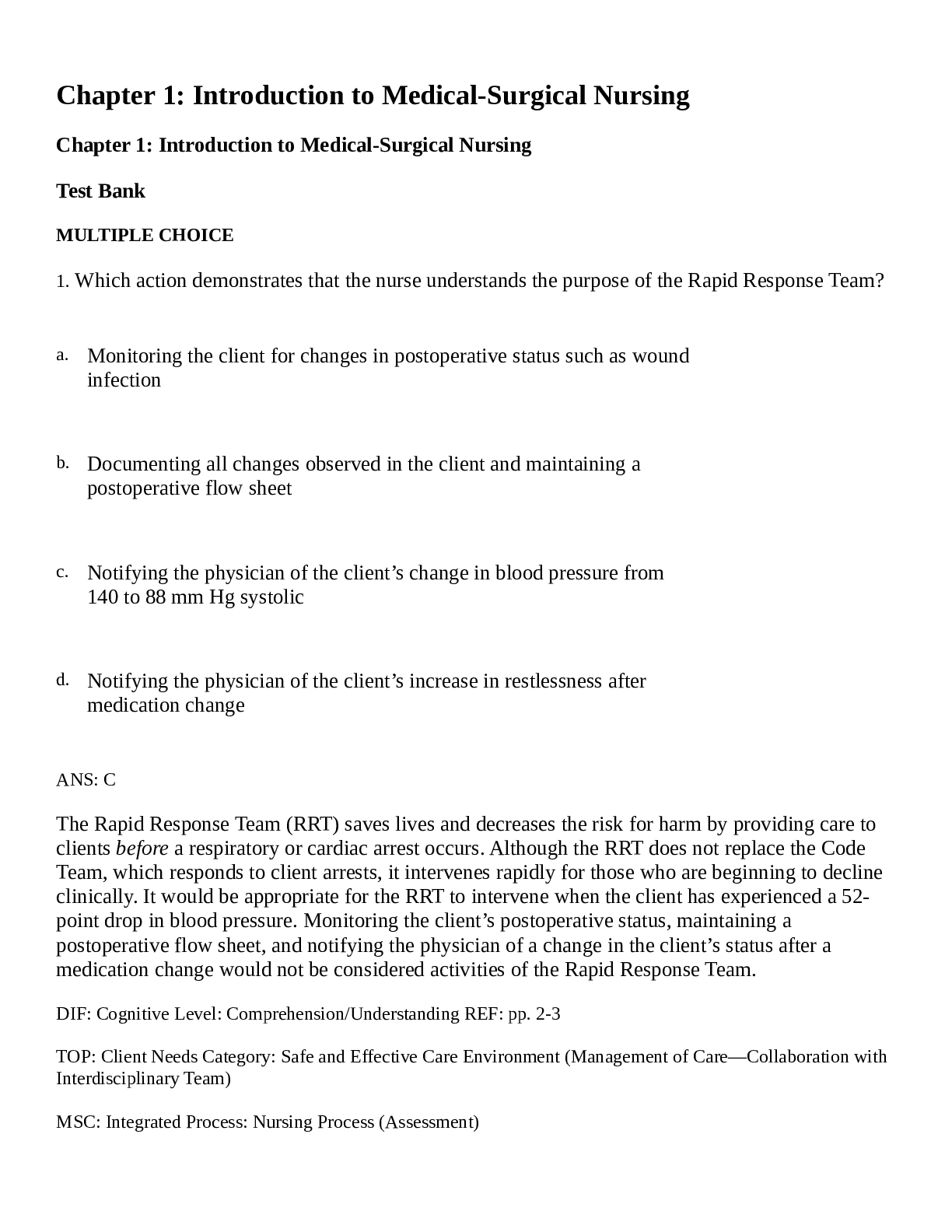


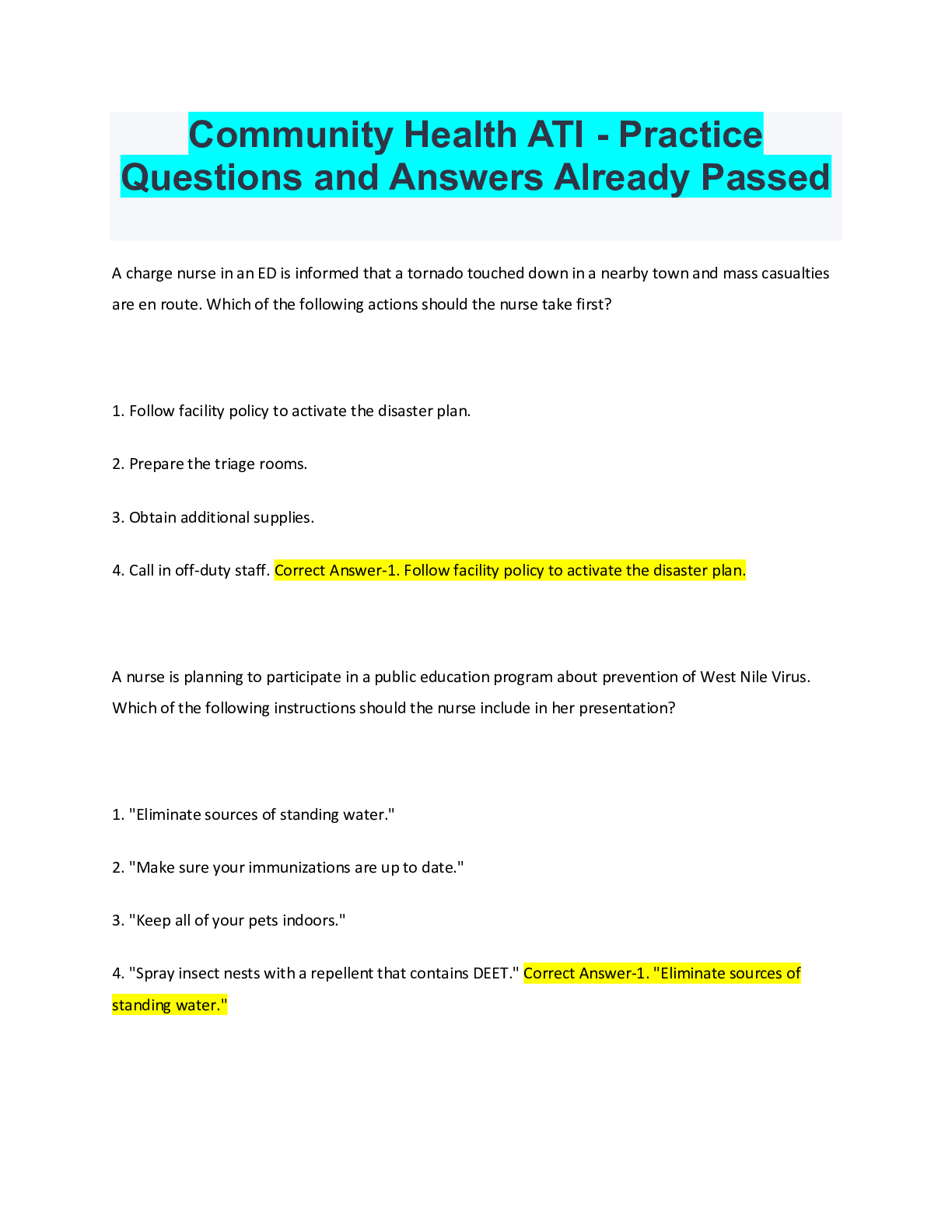
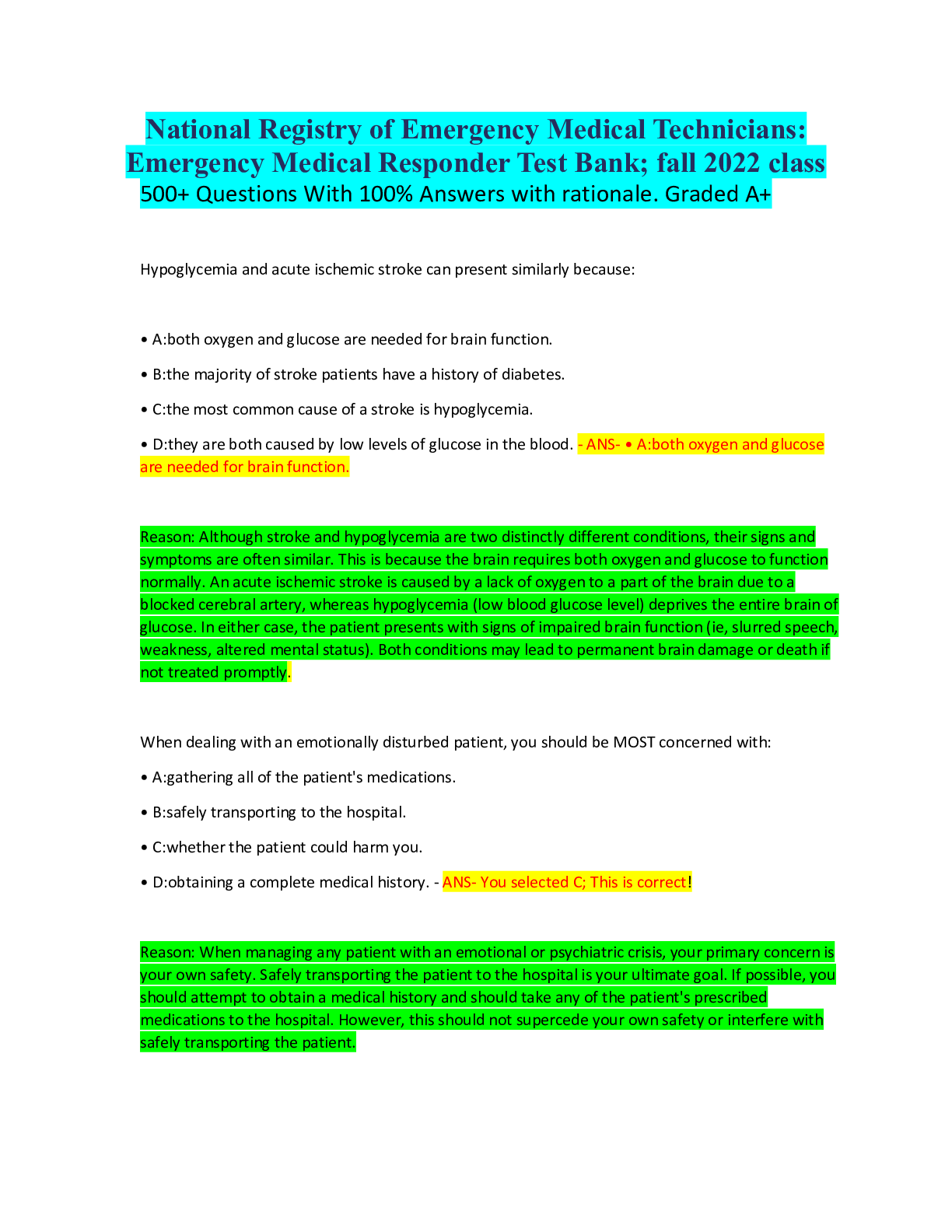




.png)

.png)
